13 Colorful Killifish Species (with Images and Quick Care Stats)
Killifish might sound exotic or elusive, but they’re actually one of the most rewarding groups of freshwater fish for aquarists of all levels. From the dazzling colors of the Clown Killifish to the bold patterns of the Blue Gularis, these small fish pack a surprising amount of personality and beauty into their modest size.
Many species are hardy, peaceful, and well-suited to small, planted aquariums — making them a perfect choice for beginners looking for something unique, yet manageable. For more experienced aquarists, killifish offer the joy of breeding challenges, seasonal varieties, and rare color morphs that bring variety and engagement to any fish room.
In this guide, we highlight 13 of the most vibrant and accessible killifish species, complete with care stats and photos to help you find your next aquatic gem.
- Geography of Killifish
- Types of Popular Killifish
- Killifish Lifecycle
- Caring for Killifish
- Conclusion
Geography of Killifish
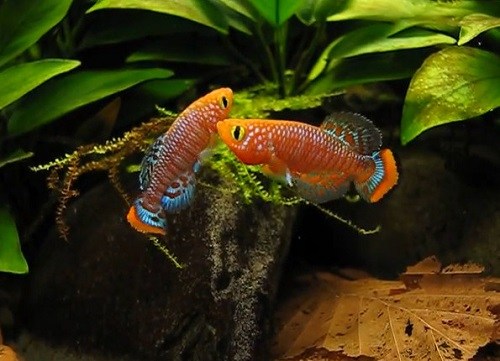
Killifish belong to the order Cyprinodontiformes and inhabit freshwater regions on nearly every continent, with over 1,200 species worldwide. While their bright colors evoke tropical environments, many species thrive in colder, less tropical habitats, showcasing their adaptability.
In the wild, killifish are often found in temporary water sources such as pools, swamps, creeks, and brackish estuaries. Some even inhabit shallow streams. They prefer environments with heavy vegetation, including dense aquatic plants and some terrestrial vegetation, which provide shelter and mimic their natural habitats.
This guide explores some of the most popular killifish varieties, detailing their temperament, environmental needs, and critical care information to help you choose the best species for your tank.
Types of Popular Killifish
Clown Killifish
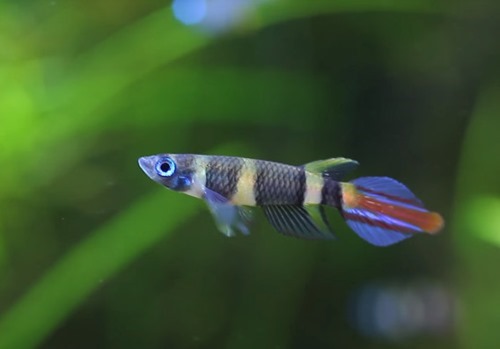
- Scientific name: Epiplatys annulatus
- Care level: Moderate
- Temperament: Peaceful
- Lifespan: 5 years
- Size: 1.2–1.4 inches
- Tank size: 5–10 gallons
- Water: 69–78°F, pH 4.0–7.0
- Diet: Carnivore
The clown killifish owes its name to the bold, black stripes that run around their bodies, as well as their gorgeous blue and red tails. The fact that they harken to some highly popular saltwater fish should make them appealing to any freshwater tank owner. They are straightforward to care for and are very peaceful.
What’s lovely about them is their ability to do well in smaller tanks – often doing well in setups as small as 10 gallons. Their adult size caps at just over 1 inch, and they can live up to five years. When comfortable in their surroundings, they are sociable, active fish.
However, for clown killifish to be comfortable, they need to have a well-decorated tank with lots of plants and rocks. These killifish tend to be top dwellers, so they will do well with other peaceful bottom dwellers in your tank, but they also do well with other killifish.
Red-Striped Killifish

- Scientific name: Aphyosemion striatum
- Care level: Easy
- Temperament: Peaceful
- Lifespan: 3–5 years
- Size: 2 inches
- Tank size: 10 gallons
- Water: 68–73°F, pH 6.5–7.5
- Diet: Carnivore
The red-striped killifish is another easy-to-care-for peaceful fish, perfect for beginner tanks. They are a little bigger than some of the other killifish on this list, maxing out at 2 inches but should also do fine in a smaller tank setup. You can put a couple of them in a 10-gallon tank.
They do well in planted tanks and benefit from quality tank décor that mimics their natural habitat. The red-striped killifish is thin with zigzagging stripes in blue and orange, with bright red dots. Their coloring is very unique and brilliant and based on that fact alone, you should consider adding them to your tank.
Another consideration with red-striped killifish is to create a slightly acidic, soft water environment. The tank should be darker and needs to have a tight-fitting lid. These little guys can jump out of the tank.
Magnificus Killifish
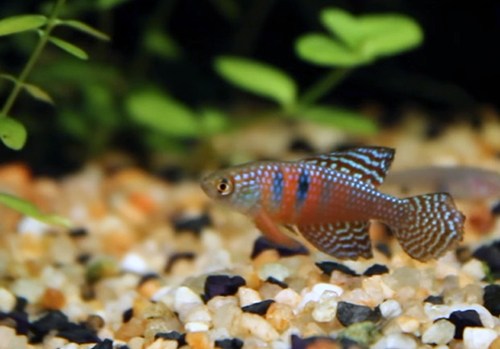
- Scientific name: Hypsolebias magnificus
- Care level: Easy
- Temperament: Peaceful
- Lifespan: 2 years
- Size: 1 inch
- Tank size: 5–10 gallons
- Water: 72–75°F, pH 5.0–7.2
- Diet: Carnivore
The magnificus killifish is aptly named for its magnificent coloring of bright blue with lots of multicolored striping. This look is finished off with lots of shiny dots on its fins and on its tail. In addition to being a stunning-looking fish, it is easy to care for and is recommended for beginners.
It has a peaceful temperament, and it gets along well with other tropical fish. The magnificus killifish has a shorter lifespan of about two years, and it only grows to about 1 inch. While tiny and shorter-lived, one perk is that it can be happy in tanks as small as 10 gallons.
The magnificus needs soft water and benefits from a heated tank that has plenty of plant cover for it to swim around. Adding things such as driftwood and floating plants will help create a peaceful, pleasant environment to minimize stress and increase happiness for your fish.
Chocolate Lyretail
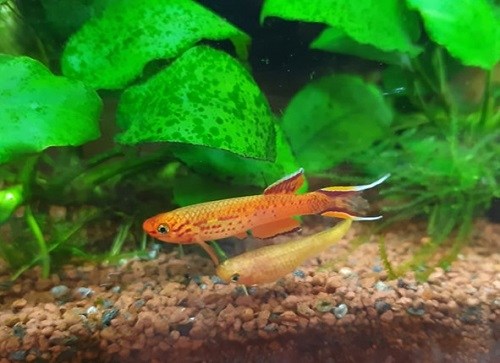
- Scientific name: Aphyosemion australe
- Care level: Easy
- Temperament: Peaceful
- Lifespan: 2 years
- Size: 2–3 inches
- Tank size: 10 gallons
- Water: 70–75°F, pH 6.0–6.5
- Diet: Carnivore
The chocolate lyretail is a medium-sized killifish that reaches around 3 inches. It lives for an average of 2 years and does fine in 10-gallon tanks, although they could benefit greatly from having a bit larger setup as well. While orange isn’t necessarily the color you think of when you think of chocolate, the chocolate lyretail most often comes in vibrant red-orange color.
Other specimens are sometimes in lighter shades of brown and sort of look more chocolate-like, but their vibrant scales take a bit away from the food analogy. Males tend to be brighter in color than females. The males are also the ones that have a pointy tail, reminiscent of a lyre.
The chocolate lyretail prefers warm, acidic water and benefits from a planted tank with lots of plant cover. While these fish are friendly and adaptable, keeping their environment low stress will result in healthier, more vibrant-looking fish.
Blue Lyretail
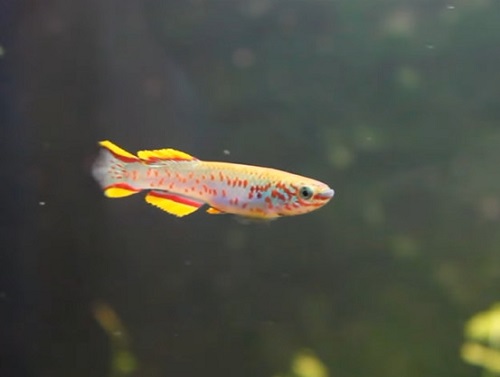
- Scientific name: Fundulopanchax gardneri
- Care level: Moderate
- Temperament: Semi-aggressive
- Lifespan: 3 years
- Size: 2.5 inches
- Tank size: 10 gallons
- Water: 68–79°F, pH 6.0–7.5
- Diet: Omnivore
The blue lyretail is a longer-lived killifish that reaches an adult size of 2.5 inches. It is a little bit more aggressive than other killifish on this list only in that it doesn’t do well with lots of males of the same species. In a smaller tank, limit the number of male blue lyretails to one male per four females and these fish should show little aggression.
When identifying the males from the females, know that the males are brighter in color than the females. The male blue lyretails also have their namesake lyre-shaped yellow tails.
Additionally, many folks who keep blue lyretails have commented that they are always hungry. Keeping these fish well-fed is the key to keeping them happy. The happier they are, the less stressed and less aggressive they will tend to be. However, quality food is key. Make sure their diet is balanced between live or frozen food and flakes. If you are considering breeding them, a primarily live diet is highly recommended.
Two Stripe Lyretail
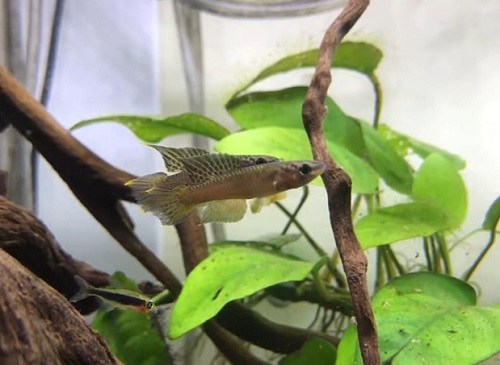
- Scientific name: Aphyosemion bivittatum
- Care level: Easy
- Temperament: Peaceful
- Lifespan: 3–5 years
- Size: 2 inches
- Tank size: 10 gallons
- Water: 70–79°F, pH 5.5–7.0
- Diet: Carnivore
The two stripe lyretail has a peaceful temperament and is one of the best killifish on this list for beginners. Brightly colored with some variation between specimens, they have two dark red stripes that run along their body. Their fins are green, blue, and include some orange.
Like many other killifish on this list, they are easygoing and are great with other fish in the tank. They are longer-lived than most killifish – living an average lifespan of about 5 years. Their adult size is around 2 inches. They prefer a slightly warm, slightly acidic tank, but are adaptable to a range of temperatures.
While carnivorous, they do not tend to hunt other fish but can become competitive for food with other top-dwelling fish. Either make sure all fish are getting fed adequately or avoid placing too many top dwellers in the same tank as the two stripe lyretail. They are native to rivers in Nigeria and benefit from having floating plants and bogwood in their tank.
Argentine Pearlfish
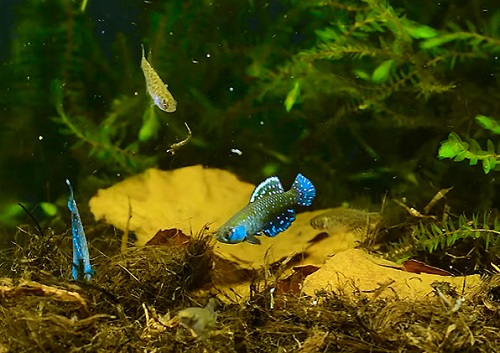
- Scientific name: Austrolebias bellottii
- Care level: Moderate
- Temperament: Semi-aggressive
- Lifespan: 8 months
- Size: 2.75 inches
- Tank size: 15 gallons
- Water: 65–72°F, pH 6.5–7.0
- Diet: Carnivore
The Argentine pearlfish is much more challenging to keep than other fish on this list. It grows to almost three inches and is happy in a 15-gallon tank. However, it does have a shorter lifespan. This would be a great killifish to work with if you are interested in breeding them.
While not super vibrant in color, at least not compared to other fish on this list, they do have a generous sprinkling of tear-shaped white dots on the surface of their dark blue bodies. Argentine pearlfish can be aggressive, especially around breeding time. The best way to avoid this is to only keep Argentine pearlfish in the tank and make sure that there is only one male per five females.
Because of their unique environment, it is best to keep a thin layer of substrate in the tank along with lots of plants. Pristine water quality is essential to keeping this fish healthy and low stress if you’re considering breeding.
Kisaki Killifish
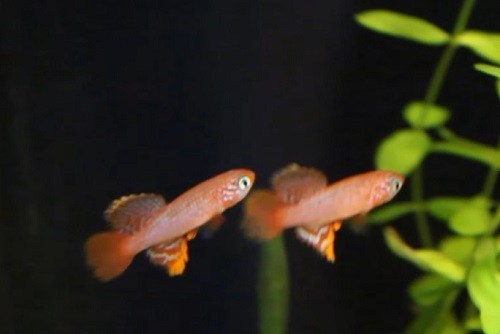
- Scientific name: Nothobranchius flammicomantis
- Care level: Easy
- Temperament: Peaceful
- Lifespan: 1–2 years
- Size: 2.5 inches
- Tank size: 10 gallons
- Water: 70–80°F, pH 6.5–7.0
- Diet: Carnivore
Kisaki killifish is an easy-to-care-for, peaceful fish. It has a shorter lifespan of one to two years and only grows to about 2 inches. 20-gallon tanks are more than enough space to start this fish in. They have an intriguing appearance, bright red with piercing blue eyes. They love a warm tank.
Since the Kisaki killifish is used to living in ponds and slow streams, it benefits from having a sandy substrate that it can burrow in. Another thing to keep in mind is that they can become aggressive if too many males are kept in the same tank. It is best to have one male to a few females in a tank. If you want to have multiple males in a tank, you will need to have a larger tank so the males can spread out.
Although the Kisaki killifish is peaceful, keeping one male with several females in a small tank is best. If you want more than one male, keep Kisaki killifish in a larger tank of at least 20 gallons so that the males have enough space and don’t fight for territory.
American Flagfish
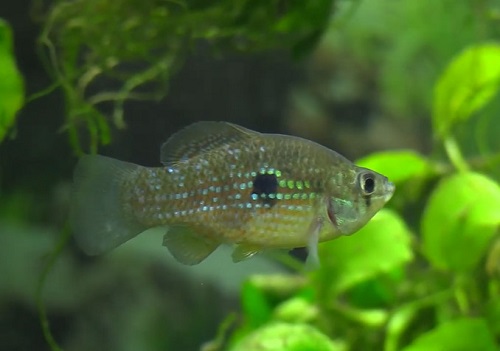
- Scientific name: Jordanella floridae
- Care level: Moderate
- Temperament: Semi-aggressive
- Lifespan: 1–2 years
- Size: 2.6 inches
- Tank size: 15 gallons
- Water: 59–70°F, pH 7.0–8.0
- Diet: Omnivore
The American flagfish is a slightly more challenging killifish to care for. Like some of the killifish on this list, it is semi-aggressive. However, the American flagfish only tends to be aggressive during the mating period. It is also a little less common than others, but it is interesting to some collectors in that it comes from the swamps of Florida.
Funnily enough, it has the colors of the American flag – white/silver, red, and blue in brilliant stripes on its body. While mostly peaceful and able to coexist with other species of similar sizes and temperaments, as mentioned above, it is essential to monitor the fish’s behavior during breeding periods.
The American flagfish can live around 2 years. This is also one of the killifish that is an omnivore – so if using live plants, note that your American flagfish might take a bite or two out of the plants in your tank.
Blue Gularis
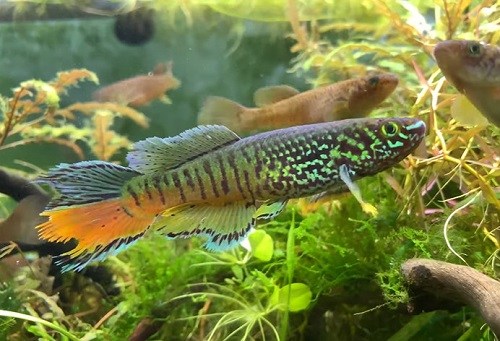
- Scientific name: Fundulopanchax sjoestedti
- Care level: Moderate
- Temperament: Semi-aggressive
- Lifespan: 5 years
- Size: 3.5–5 inches
- Tank size: 20 gallons
- Water: 73–79°F, pH 6.0–7.0
- Diet: Carnivore
Blue gularis are another kind of killifish that is a bit more challenging to keep. They have a longer lifespan of about 5 years and grow to about 5 inches. They are gorgeous swimmers and feature blue and green fins. They should be kept in a tank of at least 20 gallons.
Because they are from tropical swamps, blue gularis need a heavily planted tank with a dark, soft substrate. They should have lots of areas to shelter in. They do not need a lot of light, in fact, do better without it. In addition to needing a heavily decorated tank, the blue gularis also needs pristine water quality to stay healthy.
They can become aggressive if they are feeling stressed. They will also become food dominant with other fish in the middle and lower sections of the tank. They may fight over food and territory, so it is best to keep them with fish that prefer feeding in the upper parts of the tank.
Redtail Notho
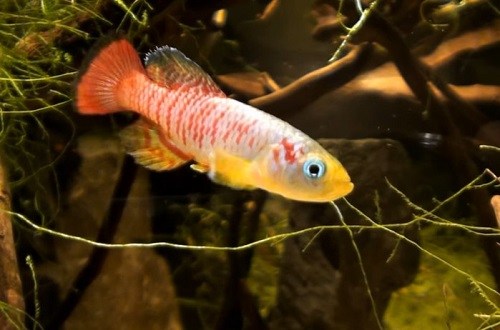
- Scientific name: Nothobranchius guentheri
- Care level: Easy
- Temperament: Peaceful
- Lifespan: 1–2 years
- Size: 2.5 inches
- Tank size: 10 gallons
- Water: 70–80°F, pH 6.0–6.5
- Diet: Carnivore
The redtail notho has a 2-year lifespan and grows to an adult size of over 2 inches. It likes a warmer tank but is happy with a smaller setup of about 10 gallons. It is easy to care for and has a peaceful temperament. Its colors, as the name implies, are red and blue.
You have probably seen this fish before as it is one of the most popular killifish among freshwater aquarists. They are easy to care for because they are so friendly, have bright beautiful colors reminiscent of saltwater fish, and are highly adaptable to varying tank conditions. They are happiest in a pretty warm tank with pristine, clean, and clear water.
Of note, be aware when adding more than one male to a small tank. They can become territorial if too many males are in a tank.
Blue Notho
- Scientific name: Nothobranchius guentheri
- Care level: Easy
- Temperament: Peaceful
- Lifespan: 1–2 years
- Size: 2.5 inches
- Tank size: 10 gallons
- Water: 70–80°F, pH 6.0–6.5
- Diet: Carnivore
The blue notho is another easy-to-handle killifish. This small fish has metallic blue fins and tail, and a bright orange body. It is a close relative of the redtail notho and shares many common characteristics. However, unlike the redtail notho, blue nothos are used to warm waters, dark substrate, leafy plants, and dim lighting.
They are one of the kinds of killifish that have a shorter lifespan and a bit smaller size. One thing to keep in mind is that the blue notho is an excellent beginner fish that adapts well to a community of fish and can handle fluctuating water temperatures.
Golden Wonder Panchax
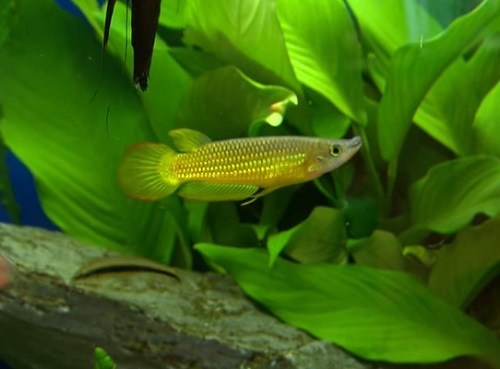
- Scientific name: Aplocheilus lineatus
- Care level: Easy
- Temperament: Semi-aggressive
- Lifespan: 4 years
- Size: 3.9 inches
- Tank size: 20 gallons
- Water: 72–75°F, pH 6.0–6.5
- Diet: Carnivore
The golden wonder panchax is a rather large killifish that can reach a size of almost 4 inches. It also lives a bit longer than many killifish, with lifespans as long as 4 years. Like its name, it is a wonderful golden color, sure to brighten up any tank. It is highly adaptable to most tank conditions but will do best in a warm, slow-moving tank.
While generally peaceful, it can become aggressive if there are too many smaller fish in the tank. The golden wonder panchax is a carnivore and will hunt smaller fish. It also does not do well with too many other golden wonder panchax in the tank – more than four will also cause aggression in the golden wonder. Finally, because of its semi-aggressive nature and larger size, this fish should be housed in a tank larger than 20 gallons.
Killifish Lifecycle
What’s particularly fascinating about killifish is their lifecycle. While not true for all killifish, some have a lifecycle that lasts less than a year. These killifish have adapted to this short lifecycle because of the environment that some of these fish come from. Some riverbed and pond environments dry up over the course of the year and then flood the following rainy season again. While the adult fish die when the riverbeds dry out – they leave behind eggs that, when rehydrated by rainwater, can hatch, and start the cycle over again.
Fortunately, when keeping killifish in aquariums, they can live much longer than a year, many living up to 5 years. However, when considering breeding some types of killifish, the eggs do need to go through a dry cycle to simulate their natural environment and stressors essential to their evolution. Besides that, killifish are some of the most enjoyable and rewarding fish to have in an aquarium.
Caring for Killifish
You’ve seen in the previous summaries about specific types of killifish that most will do fine in smaller tanks. Generally, it actually takes a lot more maintenance to keep a small tank running healthily than a larger one. While these fish can be kept in tanks as small as 10 gallons, if you are a true beginner you might actually consider starting with a 20-gallon–60-gallon tank. If you do plan on keeping more than one male killifish in a tank, you must have at least 20 gallons. Too little space and the fish will fight, often resulting in injury and sometimes death.
One challenge area for some beginners might be killifish’s nutritional needs. Most killifish are carnivores and do best when given fresh or frozen foods in addition to flakes or pellets. Some examples of great frozen or live foods for killifish include foods such as bloodworms, daphnia, brine shrimp, and tubifex worms.
Killifish also have some tank-specific needs to consider. They live in low light conditions and do better in tanks that are dim. They need lots of plants and hiding spaces to emulate their natural habitats. As with any kind of fish, emulating their natural environment is a great way to reduce stress and increase comfort, resulting in happier, healthier fish. Finally, it is strongly recommended that you keep a lid on your killifish tank. Many of these fish will jump if given the opportunity.
Finally, killifish do great with other fish, especially ones that don’t look the same as them. Some great starters are: Neon tetra, Dwarf cichlids, Gourami, Livebearers.
Many male killifish are fine with other female killifish, and females are fine with other female killifish. The main challenge to watch out for is too many male killifish in the same tank.
Conclusion
As you can see by the 13 different killifish types described in this article, they are gentle and peaceful, and great beginner-friendly additions to any tank. They are beautiful and have vibrant personalities and can bring joy to all kinds of hobby aquarium keepers. Before beginning your journey into the fascinating adventure of keeping killifish, here are a few things to keep in mind.
- Killifish tend to be very peaceful and are great community fish but exercise caution when adding more than one male in a tank. Overcrowding a tank can also lead to stress and aggression.
- Killifish are highly adaptable but generally prefer warmer tanks that have soft water.
- Make sure that your killifish tanks have lots of décor and places for killifish to hide and explore.
- Smaller tanks of around 10 gallons are fine for smaller setups for killifish but know that giving your fish more space is a great way to minimize stress.
Keeping all of the above in mind and the information presented in this article should get you well on your way to caring for a wide variety of killifish in your own aquarium.

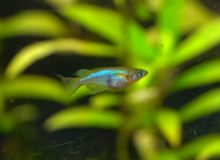
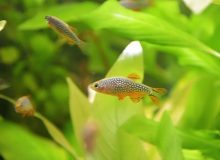
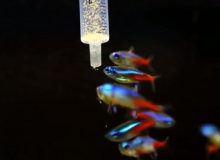
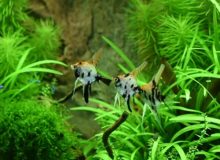
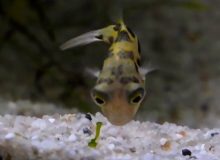

Leave a Reply